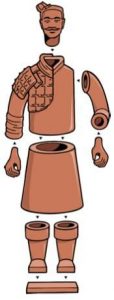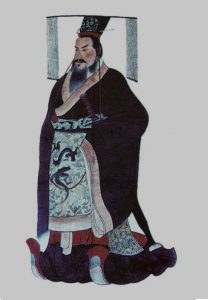14 The People Who Created the First Emperor’s Tomb
Amy Attias
Key terms
- Terracotta warriors
- First Emperor (Qin Shi Huangdi)
- Artisans
Introduction
The immense amount of time and money spent on physically protecting world leaders today typically ends either a few years after their term ends, or at the latest at their time of death. This was most certainly not the case in early China as there was a belief that people continued to live, and thus needed to be protected, in the afterlife. The terracotta warriors built for the tomb of the first emperor of early China, Qin Shi Huangdi, exemplify the power the head of the country had. These highly detailed warriors were built during the Qin dynasty (221-206 BCE). The terracotta army highlights the exploitation of the thousands of workers whose lives were uprooted to protect a single individual in the afterlife. While the craftsmanship of the warriors, horses, and weapons found in the tomb are undoubtedly beautiful, the lives of the people who made these sculptures was anything but. This section looks at the different types of tomb workers and their daily lives while building the terracotta army.

Why was the tomb built?
Before delving into who made the tomb and the terracotta army, the purpose of building this massive site must be known. Qin Shi Huangdi wanted to re-create a model of the empire he ruled. The warriors were built to protect the emperor in the afterlife from the many enemies he made during his time on Earth. It was believed that when the emperor died, these soldiers would truly be able to protect the emperor. This was taken very seriously as hundreds of thousands of workers were employed or forced to spend their lives creating these figures. In addition to warriors they also created weapons, horses, and war chariots. [1]
How were the warriors made?
It is important to understand how these warriors were made in order to comprehend the daily lives of the workers. The large number of workers built a formidable army that included infantry men, archers, officers, generals, cavalrymen, and charioteers. The soldiers were each comprised of seven major pieces: plinth, feet, calves, upper body, arms, hands, and a head. These key components were molded together with wet clay to form a lifelike warrior. A striking feature of these warriors is that each one has unique facial and body characteristics. While the parts of the soldiers all came from a mold, they were passed onto artisans who worked by hand to individualize each part. There were also several versions of each mold, including eight different types of heads and upper bodies and seven different types of shoes. The parts were then painted to add another layer of uniqueness to each individual. [2]

Who made the warriors?
While all of the people working to build the terracotta army were working towards the same goal of completing the tomb, they came from diverse backgrounds. The nearly 700,000 workers originated throughout the Qin empire and varied from expert artisans to indebted workers all the way to prisoners. There are at least eighty-seven names of workers inscribed on the army. There were state artisans employed by royal workshops, whose expertise actually came from being “… skilled at fitting pipes and mass-producing bricks or roof tiles.” [3] There were also artisans who normally worked in their own private shops. The artisans were given the basic needs of food and shelter while they worked and were employed to carry out their labor tax to the emperor. These artisans were lucky enough to only have to work on the tomb for one month before returning to their personal workshops at home. It is interesting to note that warriors made by state artisans were more refined and of a higher quality than those made by private artisans employed for a short period of time. The artisans were the more fortunate group as the other workers, criminals and indebted citizens, were forced to do less desirable tasks under worse working conditions. While the craftsmen sculpted and painted the figures, prisoners were assigned physically demanding jobs in constructing the tomb itself and the mausoleum. [4]
Exhaustion and diseases that ravaged through the working community were common causes of death for lower class workers. The difference between the social classes of the workers goes beyond their daily tasks and how long they worked for the emperor. It is also revealed in the food they consumed. Biological analysis reveals that artisans ate a diet comprised of mainly millet or animals who consumed millet. The diet of prisoners consisted of more wild animals and less millet, suggesting they came from the southern part of the empire.[5] Perhaps the most disturbing part of the lives of the artisans and workers comes from a passage by the historian Sima Qian. It describes the concern that the workers at the tomb may tell others about all of the valuable treasures hidden within. Since the tomb’s location was supposed to be a secret, the second emperor closed the middle gate “… and the outer gate closed to imprison all the artisans and laborers, so that not one came out.” The disregard for human life, especially those that labored to serve their leader in his afterlife, is abominable ..[6]

Conclusion
Visiting the terracotta warriors in person, or even looking closely at the intricate details of each figure online, is a spectacular sight. Despite the wonder and magnificence the terracotta army represents, the workers who built them cannot be forgotten. Both artisans and prisoners, although treated differently and assigned separate tasks, put forth an enormous amount of effort to make a remarkable tomb for the first emperor. Unfortunately, many of these hard workers were thanked by dying of exhaustion and disease, or being killed in fear of the workers revealing the location and treasures inside the tomb to others. Behind the thousands of unique warriors lies multiple real workers whose lives were dedicated to creating this masterpiece.
Bibliography
Barbieri-Low, Anthony J. Artisans in Early Imperial China. Seattle: University of Washington Press, 2007.
Ma, Ying, Benjamin T. Fuller, Weigang Sun, Songmei Hu, Liang Chen, Yaowu Hu, and Michael P. Richards. “Tracing the Locality of Prisoners and Workers at the Mausoleum of Qin Shi Huang: First Emperor of China (259-210 BC).” Scientific Reports 6, no. 1 (2016): 1–8. https://doi.org/10.1038/srep26731.
- Lothar Ledderose, Ten Thousand Things: Module and Mass Production in Chinese Art, Bollingen Series, XXXV : 46 (Princeton, NJ: Princeton University Press, 2000), 54. ↵
- Barbieri-Low, Artisans in Early Imperial China, 4. ↵
- Barbieri-Low, Artisans in Early Imperial China, 8. ↵
- Barbieri-Low, Artisans in Early Imperial China, 9-10. ↵
- Ying Ma et al., “Tracing the Locality of Prisoners and Workers at the Mausoleum of Qin Shi Huang: First Emperor of China (259-210 BC),” Scientific Reports 6, no. 1 (2016), 1. ↵
- Ledderose. Ten Thousand Things, 56. ↵
